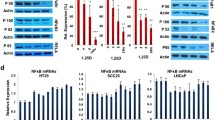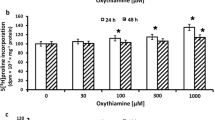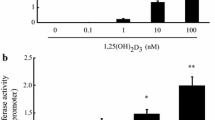Summary
Agents that increase intracellular cAMP (cAMP elevating agents) and 1,25(OH)2D3 inhibit the proliferation of many cell types. We investigated the combined effect of 1,25(OH)2D3 and cAMP elevating agents on exponentially growing mouse 3T3 fibroblasts. The following cAMP elevating agents were used: theophylline and pentoxyfilline, which inhibit cAMP-dependent phosphodiesterase; prostaglandin E2 which activates adenylate cyclase by a receptor-mediated mechanism; forskolin, which directly stimulates adenylate cyclase; and the cell permeable cAMP analogs 8-bromo cAMP and N6 benzoyl cAMP. 1,25(OH)2D3 and cAMP elevating agents were added to exponentially growing fibroblasts cultured in 96-well microtiter plates and cell number was monitored 3–7 d later. 1,25(OH)2D3 and the cAMP elevating agents as single agents inhibited the growth of the 3T3 cells. The combined treatment of the fibroblasts with 1,25(OH)2D3 and the cAMP elevating agents resulted in an antiproliferative effect that was more than additive. The synergistic interaction depended on the dose of 1,25(OH)2D3 and was apparent already at 10−8 M of the hormone. The specificity of the effect of 1,25(OH)2D3 was demonstrated by the finding that 24,25-dihydroxyvitamin D3, a vitamin D metabolite with low affinity for the vitamin D receptor, did not affect the antiproliferative effect of cAMP elevating agents. From the synergistic interaction between 1,25(OH)2D3 and the cell permeable cAMP analogs, we infer that the site of interaction between the two signaling pathways is distal to the cAMP generating and degrading machinery.
Similar content being viewed by others
References
Al-Abdaly, F.; Henry, H. L. Hormonal regulation of chick kidney inhibitor of adenosine 3′,5′-monophosphate-dependent protein kinase. Endocrinology 124:2901–2906; 1989.
Baran, D. T. Nongenomic actions of the steroid hormone 1α,25-dihydroxyvitamin D3. J. Cell. Biochem. 56:303–306; 1994.
Berg, J. P.; Torjesen, P. A.; Haug, E. 1,25-Dihydroxyvitamin D3 attenuates TSH and 8-(4-chlorophenylthio)-cAMP-stimulated growth and iodide uptake by rat thyroid cells (FRTL-5). Thyroid 3:245–251; 1993.
Bourne, H. R.; Lichtenstein, L. M.; Melmon, K. L., et al. Modulation of inflammation and immunity by cyclic AMP. Science 184:19–28; 1974.
Colston, K. W.; Berger, U.; Coombes, R. C. Possible role for vitamin D in controlling breast cancer cell proliferation. Lancet 1:188–191; 1989.
Daly, J. W.; Padgett, W.; Seamon, K. B. Activation of cyclic AMP generating systems in brain membranes and slices by the diterpene forskolin: augmentation of receptor mediated responses. J. Neurochem. 38:532–544; 1982.
Darwish, H. M.; Burmester, J. K.; Moss, V. E., et al. Phosphorylation is involved in transcriptional activation by 1,25-dihydroxyvitamin D3 receptor. Biochim. Biophys. Acta 1167:29–36; 1993.
Heldin, N. E.; Paulsson, Y.; Forsberg, K., et al. Induction of cyclic AMP synthesis by forskolin is followed by a reduction in the expression of c-myc messenger RNA and inhibition of 3H-thymidine incorporation in human fibroblasts. J. Cell. Physiol. 138:17–23; 1989.
Hori, T.; Kashiyama, S.; Oku, N., et al. Effects of tumor necrosis factor on cell growth and expression of transferrin receptors in human fibroblasts. Cell Struct. Funct. 13:425–433; 1988.
Inaba, M.; Okuno, S.; Koyama, H., et al. Dibutyryl cAMP enhances the effects of 1,25-dihydroxyvitamin D3 on a human promyelocytic leukemia cell, HL-60, at both the receptor and the postreceptor steps. Arch. Biochem. Biophys. 293:181–186; 1992.
Ishida, Y.; Taniguchi, H.; Baba, S. Possible involvement of 1,25-dihydroxyvitamin D3 in proliferation and differentiation of 3T3-L1 cells. Biochem. Biophys. Res. Commun. 151:1122–1127; 1988.
Klaus, G.; von-Eichel, B.; May, T., et al. Synergistic effects of parathyroid hormone and 1,25-dihydroxyvitamin D3 on proliferation and vitamin D receptor expression of rat growth cartilage cells. Endocrinology 135:1307–1315; 1994.
Koren, R.; Liberman, U. A.; Maron, L., et al. 1,25-dihydroxyvitamin D3 acts directly on human lymphocytes and interferes with the cellular response to interleukin-2. Immunopharmacology 18:187–194; 1989.
Kragballe, K. Treatment of psoriasis with cacipotriol and other vitamin D analogues. J. Am. Acad. Dermatol. 27:1001–1008; 1992.
Krishnan, A. V.; Feldman, D. Cyclic adenosine 3′,5′-monophosphate upregulates 1,25-dihydroxyvitamin D3 receptor gene expression and enhances hormone action. Mol. Endocrinol. 6:198–206; 1992.
Liu, M.; Freedman, L. P. Transcriptional synergism between the vitamin D3 receptor and other non-receptor transcription factors. Mol. Endocrinol. 8:1593–1604; 1994.
Lointier, P.; Wargovich, M. J.; Saez, S., et al. The role of vitamin D3 in the proliferation of a human colon cancer cell line in vitro. Anticancer Res. 7:817–822; 1987.
Magnaldo, L.; Pouyssegur, J.; Paris, S. Cyclic AMP inhibits mitogen-induced DNA synthesis in hamster fibroblasts regardless of the signalling pathway involved. FEBS Lett. 245:65–69; 1989.
Mandla, S.; Tenenhouse, H. S. Inhibition of 24-hydroxyvitamin D3-24-hydroxylase by forskolin: evidence for a 3′,5′-cyclic adenosine monophosphate-independent mechanism. Endocrinology 130:2145–2151; 1992.
Morimoto, S.; Imanaka, S.; Koh, E., et al. Comparison of the inhibition of proliferation of normal and psoriatic fibroblasts by 1,25-dihydroxyvitamin D3 and synthetic analogues of vitamin D3 with an oxygen atom in their side chain. Biochem. Int. 19:1143–1149; 1989.
Nicholson, C. D.; Challiss, R. A. J.; Shahid, M. Differential modulation of tissue function and therapeutic potential of selective inhibitors of cyclic nucleotide phosphodiesterase isoenzymes. Trends Pharmacol. Sci. 12:19–27; 1991.
Pols, H. A. P.; van Leeuwen, J. P.; Schilte, J. P., et al. Heterologous upregulation of the 1,25-Dihydroxyvitamin D3 receptor by parathyroid hormone (PTH) and PTH-like peptide in osteoblast-like cells. Biochem. Biophys. Res. Commun. 156:588–594; 1988.
Ravid, A.; Koren, R.; Narinsky, R., et al. 1,25-dihydroxyvitamin D3 and agents that increase intracellular adenosine 3′,5′-monophosphate synergistically inhibit the mitogenic stimulation of human lymphocytes. J. Clin. Endocrinol. & Metab. 70:1687–1692; 1990.
Rowland-Goldsmith, M.; Henry, H. L. Protein inhibitor of cyclic AMP-dependent protein kinase: genomic cloning of a 1,25(OH)2D3 down regulation protein. In: Norman, A. W.; Bouillion, R.; Thomasset, M., eds. Vitamin D, a pluripotent steroid hormone: structural studies, molecular endocrinology and clinical applications. Berlin, Germany: Walter de Gruyter & Co.; 1994:292–293.
Rubin J. E.; Catherwood, B. D. 1,25-Dihydroxyvitamin D attenuates cAMP accumulation in cultured human lymphocytes. Mol. Cell. Endocrinol. 52:213–218; 1987.
Tokuda, H.; Kotoyori, J.; Suzuki, A., et al. Effect of vitamin D3 on the signaling by prostaglandin E2 in osteoblast-like cells. J. Cell. Biochem. 52:220–226; 1993.
Trydal, T.; Lillehaug, J. R.; Aksnes, L., et al. Effect of 1,25-(OH)2-vitamin D3 on growth, homologous receptor and c-myc regulation in C3H/10T1/2 cells. Mol. Cell. Endocrinol. 74:191–202; 1990.
Van Leeuwen, J. P.; Pols, H. A. P.; Schilte, J. P., et al. Modulation by epidermal growth factor of the basal 1,25(OH)2D3 receptor level and the heterologous up-regulation of the 1,25(OH)2D3 receptor in clonal osteoblast-like cells. Calcif. Tissue Int. 49:35–42; 1991.
Walters, M. R. Newly identified actions of vitamin D endocrine system. Endocr. Rev. 13:719–764; 1992.
Author information
Authors and Affiliations
Rights and permissions
About this article
Cite this article
Saati, N., Ravid, A., Liberman, U.A. et al. 1,25-Dihydroxyvitamin D3 and agents that increase intracellular adenosine 3′, 5′-monophosphate synergistically inhibit fibroblast proliferation. In Vitro Cell.Dev.Biol.-Animal 33, 310–314 (1997). https://doi.org/10.1007/s11626-997-0052-z
Received:
Accepted:
Issue Date:
DOI: https://doi.org/10.1007/s11626-997-0052-z




